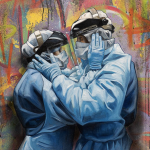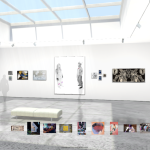Dreaming, a shared human experience and a common occurrence, shapes our nocturnal state of mind with vivid narratives that often fade and slip our conscious realm upon awakening. While some ascend to utopic realms of fantasy, others find them selves in nightmarish chases. We typically experience these stories as passive observers, with no agency over the unfolding events. But what if we could exert influence over these dreamscapes? What if we could maintain partial awareness, orchestrating our dreams and tapping into extraordinary insights from the depth of our unconscious? can we really flip the table and become architects of our nocturnal tales? These notions invite us to contemplate a different sort of dreaming, one in which we are active players rather than passive observers, lucid dreams.
“One day it will have to be officially admitted that what we have christened reality is an even greater illusion then the world of dreams” Salvador Dali.
Lucid Dreams and Scientific Scrutiny
The concept of lucid dreams has a long history of scientific scrutiny and broad skepticism. This phenomenon was first reported by Aristotle in the forth century BCE, Still, it wasn’t until the twentieth century that Dutch psychiatrist Frederik Van Eeden First coined the term “Lucid Dream”. Early on, many renown scientists apposed the possibility of conscious awareness and control in dreams, and disregarded such notion as complete heresy. However, pioneering research at Stanford and Liverpool Universities in the 1970s, empirically demonstrated that lucid dreams could communicate via eye movement during REM sleep, confirmed by electrodes.
This pivotal shift in the scientific discourse turned lucid dreaming from a topic of immense skepticism and controversy to one of scientific inquiry. This phenomenon is on the rise as a recognized skill with potential applications in therapy, personal development, and dream research. Therefore, grasping the evolution of such concept reveals how sleep research methodologies and the legitimacy of this contentious phenomenon have been argued and established across the scientific community.

Key Studies and Pivotal Perspective
- Stanford University (1970):
Findings: Conducted by Dr. William Dement and his colleagues, tracked dreamers’ eye movements, which correlated to reported dream activity indicating active awareness in dreams.
Argument: This study offered empirical evidence for lucid dreaming, demonstrating that dreamers could consciously signal that they were having a lucid experience during REM sleep.
- 2.Liverpool University:
Findings: Successfully replicating the Stanford study for empirical purposes, reaching comparable eye movement patterns in lucid dreamers.
Argument: Their scientific conclusions further reinforced the idea of lucid dreams, Implying that people can be aware of and exert control over their actions in the dreams.
- 3. Max Planck Institution:
Findings: During lucid dreaming episodes, advanced brain imaging techniques and tools revealed increased activity in regions involved in self-reflection and metacognition.
Argument: The study suggested that lucid dreaming is a separate neurological state characterized by an odd higher level of consciousness then typical dreaming.
- 4. Harvard University:
Findings: Broth forth a skeptic point of view. pondering whether lucid dreaming is a distinct condition or mere extension of waking imagination.
Argument: Proposing that experiences labeled as lucid dreams might be a mere fusion of dreaming and waking consciousness, disputing the notion of lucid dreaming as a distinct and unique phenomenon.
- 5.University of California, Berkeley:
Findings: examining the frequency and agency aspect of lucid dreaming. offering a balanced point of view.
Argument: Broth forth the idea that while lucid dreaming exists, Still, its frequency and the level of control dreamers exert may be less significant than previously believed.

Lucid Dreams and The Artistic Process
The link between lucid dreams and the artistic process has been well examined. According to one key study conducted by Nicholas Zink and Reinhard Pietrowsky from Heinrich Heine University. Lucid dreamers exhibit higher degrees of creativity then non-lucid dreamers, a conclusion reached through the extensive comparison of creativity scores.
Nevertheless, The glittery fruits of lucid dreaming in art is evident in the works of countless artists, reportedly drawing inspiration from their dreams. For example, painter Edward Burne-Jones based his painting “The Rose Bower” on a lucid dream about twelve muses on Mount Helicon. Other renowned artists, particularly in the visual arts, such as Frida Kahlo, Max Ernst, Gil Bruvel, and Salvador Dali, have been actively influenced by their dreams. This link emphasized the potential of this phenomenon as a creative tool boosting the artistic process, and allowing for a more visceral and profound exploration of subconscious materials.







